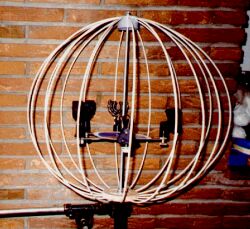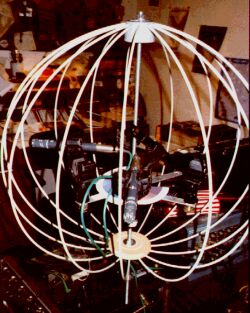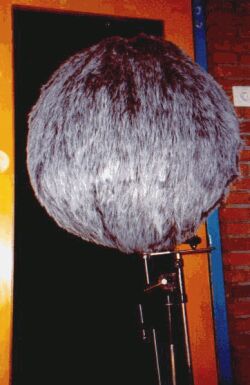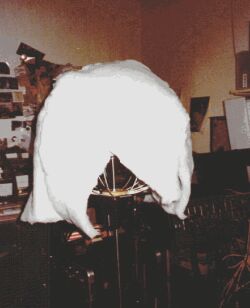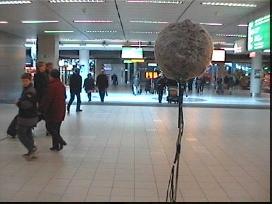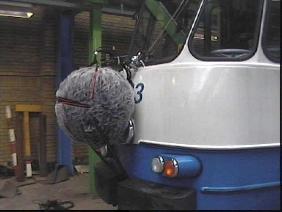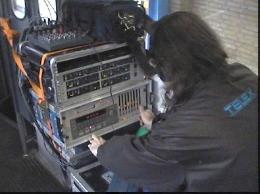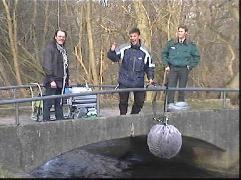PRO:
Privat:

EXPO 2000 PROJECT
( For the latest updates and more (full-size) pictures about this Project
visit : The surround-sound Pages )
![]()
Recording atmo for an A/V surround projection in 270 degrees.
Choice of Format :
6 channel discrete.
In our view the only format to give the directional information required to give an realistic sound field matching the projection:
5 cardioid mics in angles, according to the projection-centers, plus an omni mic for the post-engineer's choice to pan or use for LFE.
Choice of recording Format:
5 x Neumann KM 84
1 x AKG CK 22
3x Behringer Ultra-Gain pre-amp + Tascam DA 88
The budget had it's limits, and beside that, it fits good in the back of a car, because of it's power consumption (it had to run on a car-battery) and the dimensions.
Microphone angles: = projection angles;
L= -54 degree., C=0 degree., R=+54 degree., Lr= -108 dirge, Rr= +108 degree.
Choice of mic placement:
Personal variation on the "Ideal Cardioid Arrangement" as mentioned in the article "Tracking 5.1" AUDIO MEDIA issue 108, nov. 1999.
Mic angles = Projection angles, r=17,5 cm.
Problems:
Wind.
On our first tryout -day to see everything was working as expected, we encountered two problems.
The first was the a naval battleship testing it's RADAR, coursing a nasty buzz every time the beam passed our position at the waterline, trying to record a real impression of breaking waves at the seashore.
After moving to another location we successfully recorded another take of sea-sound but the problem of wind noise (due to another location) appeared.
The choice of pop-screen with an additional "pussycat" didn't to be sufficient enough to suppress the LF noise of the wind.
Back to the theory and the drawing-board.
Solutions:
The Fluffy Globe.
After studying the AES papers "Reduction of wind noise in microphones" by L.R.Burroughs(1961),
I decided to build a custom wind protector for the mic arrangement we decided to use.
R&D of the Fluffy Globe:
Considering the radius of the mic capsule placement (17,5 cm), and the design optimum (maximum surface, still portable), the choice was made to create a globe with a diameter of 50 cm.
Designing and Building:
On an M8 thread-rod the following was mounted: (top to bottom):
Topcap to hold 16 fiber bars (4mm diam.,75 cm long, in a (half) circular manor with an equal distance of 22,5 degrees).
6 Mic stands with shock absorbent mic-mounts.
Ground plate to fit 16 fiber bars,(4mm diam.,75 cm long, in a circular manor with an equal distance of 22,56 degrees).
All this was covered with an fabric of long-hairy, open-woven wool, which was found at the local fabric store.
.(For Full-size Pictures: Surroundsoundpics).
Testing:
Testing was done by installing 2 AKG 390 cardioid mics (in ORTF position) inside the globe and pointing an 80 Watt hairdryer outlet towards it at a distance of 30 and 15 cm from the globe.
Listening sessions and evaluation DAT recordings pointed out that a few more dB's of LF noise suppression could be gained by inserting an extra layer of isolation between the "fluffy coat" and the fiber frame.
A 35 mm thick layer of acoustic fabric ,with a density of 300 gr/sq.mtr. proved to be sufficient.
In the field:
The first day of real recording included a transfer-hall of a airport and the platform of the same airport.
The transfer-hall gave no problem at all. All air movement due to air-conditioning was excellent suppressed and really convincing surround recordings were made.
After that we went outside to the platform to record general noise including a lucky shot of a jet take-off.
The wind has increased to a 6-7 Beaufort and now we needed to use the HP filters on the pre-amps.
Cutting frequencies @ 40 Hz. were OK to get rid of the wind-rumble.
The "Fluffy Onion" worked.
The Transfer-hall
After the airport we had planned to record open landscape in the polder but the wind was still increasing and after lunch it turned out to be impossible to record anything but the sound of a storm.
On our way home we successfully recorded the sound of a wind-turbine because we needed that too in mono as an effect, but we were there and it made a superb whooossshh,whooossshh!
Our "Fluffy Onion" handled the increasing wind very well.
On our way home we visited a shopping mall to record the general noise of walking, talking people.
Very convincing 10 minutes were recorded before a security woman started to feel important with questions as: "Do you have permission to do this".
Something like: "Do you have a license to hear".
Anybody can walk around with a DV cam and make recordings but when you do it beyond a certain (technical) level ,(Which level? No-one knows!!) you need a permit (and a production-assistant to make the phone-calls and all the other things that drives-up your daily rates); Uniforms do strange things to people.
After cooling-down the situation we called it a day and went home.
Day two:
Our second day of recording was planned (by that before-mentioned production-assistant) to make moving sound fields of the point-of-view of a driver of a Amsterdam Tram (el.streetcar).
Our first option was to place the mics on top of the tram but then (as consequence) we had to wait for 14 hours for the opportunity to remove the mics, due to the transport-schedule.
So we decided to tie our "Fluffy Onion" to the nose of the tram, leading the cables through a window and see what we could capture to tape.
Because we had 2 spare tracks on the DA88, we planted a small A-B pair in the driver's cabin to add reality to the picture.
Two DPA 4060 were attached to the roof of the cabin and gave a fine recording of the sounds of radio-comm.'s and drive-handles moved.
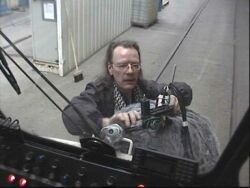 Attaching the "Fluffy
Onion"
Attaching the "Fluffy
Onion"
.(For Full-size Pictures: Surroundsoundpics).
During the tram ride, successful recordings were made for about 30 minutes, than our battery run out of power due to his age.
At the endpoint we removed the gear in 3 minutes in order not to disturb the transport-schedule.
(Thanks to all the people at Gemeentelijk Vervoers Bedrijf Amsterdam for their cooperation and assistance).
After our tram-ride we moved to the outskirts: the sounds of streaming water and a forest was asked to record. We stopped at the local car-parts dealer to obtain a new battery and drove out.
In the middle of a water-resource in the dunes near Haarlem we captured the various sounds of streaming water and wind moving the trees, accompanied by birdsong.
The third day:
After driving 30 min's, we recorded a very realistic sounfield of the control-room of a waste-plant, and the sounds of cranes, moving the junk.
After that, we relocated to the unload-platform in order to record the sound of lorries, driving-up and unloading.
(Thanks to all the people at AVI Alkmaar for their help).
In search of sounds of a crowded pub, we were unsuccessful (it was raining "cats and dogs", so there was no crowd), and decided to go out to record some moving-traffic sounds.
After two try-outs, (failed due to wind/machine-sounds), we recorded 6 minutes of superb ambience of a highway fly-over.
There is one day to go, so keep coming back for details.
Recent update: Today we visited the audio post-production studio to sort out the different parts and to listen to the results over full-range 5 way monitoring.
Often the realism of the sound-field exceeded our expectations. Specially the recordings of the streetcar and the sounds of the waste-plant were very impressive! Also the streaming-water-sound makes you want to go to the bathroom.
The directional information in the airport-hall was very good; when a coin was dropped behind us, everybody was turning around to pick it up. Also people walking by were very good to "follow", audio-wise, without "holes" between mics/speakers.
Because the mics were relatively close together during recording we were happily surprised by the phenomenon of (vertical in-phase) LF coupling. The unloading of the lorries at the waste-plant made de floor shake without any use of a subwoofer, 5 channels from the DA88 straight in the monitors.
After all a encouraging listening-experience.
We also like to thank the people at Bob Kommer Sound Studios bv for their hospitality and encouragement and we look forward to the mix-down, which must be done in the pavilion in Hanover, because for placing the effects etc., the (computer-generated) projection in 270 degrees is needed.
Dick Korporaal & Arnoud van Laer
For the latest updates and more (full-size) pictures about this Project visit : The surround-sound Pages
The DA88: http://www.aem.nl
The studio: http://www.bkssound.com

